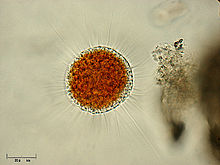You can help expand this article with text translated from the corresponding article in French. (June 2019) Click [show] for important translation instructions.
|
| Vampyrellidae | |
|---|---|

| |
| Vampyrella lateritia | |
| Scientific classification | |
| Domain: | Eukaryota |
| Clade: | Diaphoretickes |
| Clade: | SAR |
| Phylum: | Endomyxa |
| Class: | Vampyrellidea |
| Order: | Vampyrellida |
| Family: | Vampyrellidae Zopf, 1885 |
| Genera | |
| Diversity | |
| 19 species | |
The family Vampyrellidae is a subgroup of the order Vampyrellida (or Aconchulinida) within the supergroup Rhizaria.[1][2] Based on molecular sequence data, the family currently comprises the genus Vampyrella, and maybe several other vampyrellid amoebae (e.g. Gobiella).[2] The cells are naked and characterised by radiating, filose pseudopodia (also referred to as filopodia) and an orange colouration of the main cell body.[3][4]
In former times the family Vampyrellidae contained several genera (e.g. Vampyrella, Gobiella, Leptophrys, Platyreta, Theratromyxa) and was identical with the order Vampyrellida, also known under the name "Aconchulinida".[5] However, based on molecular sequence data the family Vampyrellidae was restricted to a subgroup containing only the genus Vampyrella, and a different family Leptophryidae was established for the genera Leptophrys, Platyreta and Theratromyxa.[2]
- ^ "Vampyrellidae". Retrieved 2009-03-08.
- ^ a b c Hess, Sebastian; Sausen, Nicole; Melkonian, Michael (2012-02-15). "Shedding Light on Vampires: The Phylogeny of Vampyrellid Amoebae Revisited". PLOS ONE. 7 (2): e31165. Bibcode:2012PLoSO...731165H. doi:10.1371/journal.pone.0031165. ISSN 1932-6203. PMC 3280292. PMID 22355342.
- ^ Cienkowski, L. (1865-12-01). "Beiträge zur Kenntniss der Monaden". Archiv für Mikroskopische Anatomie (in German). 1 (1): 203–232. doi:10.1007/BF02961414. ISSN 0176-7364. S2CID 84323025.
- ^ Zopf, Wilhelm (1885). Die Pilzthiere oder Schleimpilze. Breslau: Trewendt.
- ^ David Bass; Ema E.-Y. Chao; Sergey Nikolaev; Akinori Yabuki; Ken-ichiro Ishida; Cédric Berney; Ursula Pakzad; Claudia Wylezich & Thomas Cavalier-Smith (2009). "Phylogeny of novel naked filose and reticulose Cercozoa: Granofilosea cl. n. and Proteomyxidea revised". Protist. 160 (1): 75–109. doi:10.1016/j.protis.2008.07.002. PMID 18952499.